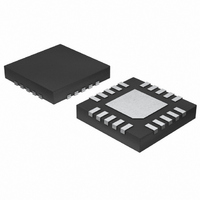MAX4409ETP+ Maxim Integrated Products, MAX4409ETP+ Datasheet - Page 10

MAX4409ETP+
Manufacturer Part Number
MAX4409ETP+
Description
IC AMP AUDIO .08W STER AB 20TQFN
Manufacturer
Maxim Integrated Products
Series
DirectDrive™r
Type
Class ABr
Datasheet
1.MAX4409ETP.pdf
(20 pages)
Specifications of MAX4409ETP+
Output Type
Headphones, 2-Channel (Stereo)
Max Output Power X Channels @ Load
80mW x 2 @ 16 Ohm
Voltage - Supply
1.8 V ~ 3.6 V
Features
Depop, Short-Circuit and Thermal Protection, Shutdown
Mounting Type
Surface Mount
Package / Case
20-TQFN Exposed Pad
Product
General Purpose Audio Amplifiers
Output Power
80 mW
Common Mode Rejection Ratio (min)
96 dB
Thd Plus Noise
0.002 %
Operating Supply Voltage
1.8 V to 3.6 V
Supply Current
5 mA
Maximum Power Dissipation
2051 mW
Maximum Operating Temperature
+ 85 C
Mounting Style
SMD/SMT
Input Bias Current (max)
0 nA
Input Offset Voltage
0.5 mV
Input Signal Type
Differential
Minimum Operating Temperature
- 40 C
Supply Voltage (max)
3.6 V
Supply Voltage (min)
1.8 V
Amplifier Class
AB
No. Of Channels
2
Supply Voltage Range
1.8V To 3.6V
Load Impedance
16ohm
Operating Temperature Range
-40°C To +85°C
Amplifier Case Style
TQFN
Rohs Compliant
Yes
Lead Free Status / RoHS Status
Lead free / RoHS Compliant
typically 0.5mV, which, when combined with a 32Ω
load, results in less than 16µA of DC current flow to the
headphones.
Previous attempts to eliminate the output-coupling capac-
itors involved biasing the headphone return (sleeve) to
the DC-bias voltage of the headphone amplifiers. This
method raises some issues:
•
•
•
•
In addition to the cost and size disadvantages of the DC-
blocking capacitors required by conventional head-
phone amplifiers, these capacitors limit the amplifier’s
low-frequency response and can distort the audio signal:
• The impedance of the headphone load and the DC-
80mW, DirectDrive, Stereo Headphone
Amplifier with Common-Mode Sense
10
blocking capacitor form a highpass filter with the
-3dB point set by:
where R
the DC-blocking capacitor value. The highpass filter
is required by conventional single-ended, single
power-supply headphone drivers to block the midrail
DC bias component of the audio signal from the
headphones. The drawback to the filter is that it can
attenuate low-frequency signals. Larger values of
C
er, more expensive capacitors. Figure 2 shows the
relationship between the size of C
ing low-frequency attenuation. Note that the -3dB
point for a 16Ω headphone with a 100µF blocking
capacitor is 100Hz, well within the normal audio
band, resulting in low-frequency attenuation of the
reproduced signal.
When combining a microphone and headphone on
a single connector, the microphone bias scheme
typically requires a 0V reference.
The sleeve is typically grounded to the chassis.
Using this biasing approach, the sleeve must be
isolated from system ground, complicating product
design.
During an ESD strike, the driver’s ESD structures
are the only path to system ground. Thus, the driver
must be able to withstand the full ESD strike.
When using the headphone jack as a line out to other
equipment, the bias voltage on the sleeve may con-
flict with the ground potential from other equipment,
resulting in possible damage to the drivers.
OUT
______________________________________________________________________________________
reduce this effect but result in physically larg-
L
is the headphone impedance and C
f
-
3
dB
=
2
π
Low-Frequency Response
R C
L OUT
1
OUT
and the result-
OUT
is
• The voltage coefficient of the DC-blocking capacitor
The combination of low-frequency attenuation and fre-
quency-dependent distortion compromises audio
reproduction in portable audio equipment that empha-
sizes low-frequency effects such as multimedia lap-
Figure 2. Low-Frequency Attenuation for Common DC-Blocking
Capacitor Values
Figure 3. Distortion Contributed by DC-Blocking Capacitors
contributes distortion to the reproduced audio signal
as the capacitance value varies as a function of the
voltage change across the capacitor. At low fre-
quencies, the reactance of the capacitor dominates
at frequencies below the -3dB point and the voltage
coefficient appears as frequency-dependent distor-
tion. Figure 3 shows the THD+N introduced by two
different capacitor dielectric types. Note that below
100Hz, THD+N increases rapidly.
0.0001
0.001
-10
-15
-20
0.01
-25
-30
-35
0.1
-3
-5
10
0
1
10
10
330μF
TO DC-BLOCKING CAPACITORS
ALUM/ELEC
LF ROLL OFF (16Ω LOAD)
ADDITIONAL THD+N DUE
220μF
100μF
100
33μF
FREQUENCY (Hz)
FREQUENCY (Hz)
TANTALUM
100
1k
-3dB CORNER FOR
100μF IS 100Hz
10k
100k
1k











